《生物多样性导论》课程教学课件(PPT讲稿)15 农田生态系统中生物多样性应用

Agar gel film bromocresol purple Mixed faba bean +P Mixed faba bean-P Mixed maize +P Mixed maize-P Faba bean acidified its rhizosphere via proton exudation from roots,whereas maize did not. 2025-6-17 Li et al.,200PWAS104(27):11192-11196
2025-6-17 Prof. Dr. Li L 1 Mixed faba bean +P Mixed faba bean –P Faba bean acidified its rhizosphere via proton exudation from roots, whereas maize did not. Mixed maize +P Mixed maize -P Agar gel film + bromocresol purple Li et al., 2007 PNAS 104 (27): 11192-11196
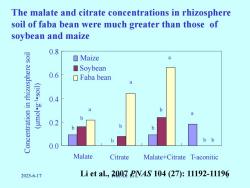
The malate and citrate concentrations in rhizosphere soil of faba bean were much greater than those of soybean and maize 0.8 ▣Maize ☐Soybean 0.6 ☐Faba bean (I!os.13.ou) 0.4 0.2 0.0 Malate Citrate Malate+Citrate T-aconitic 2025-6-17 Li et al.,Q0RNAS104(27):11192-11196
2025-6-17 Prof. Dr. Li L 2 b b b a a b b a a b b b 0.0 0.2 0.4 0.6 0.8 Malate Citrate Malate+Citrate T-aconitic C o n c e n t r a t i o n i n r h i z o s p h e r e s o i l ( μ m o l • g -1• s o i l ) Maize Soybean Faba bean The malate and citrate concentrations in rhizosphere soil of faba bean were much greater than those of soybean and maize Li et al., 2007 PNAS 104 (27): 11192-11196
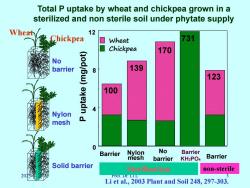
Total P uptake by wheat and chickpea grown in a sterilized and non sterile soil under phytate supply Wheaty 12 Chickpea Wheat 731 Chickpea No barrier 8 123 4 Nylon mesh 0 Barrier Nylon No Barrier mesh barrier KH2PO4 Barrier Solid barrier Bte2112a1100 non-sterile 202 ProI.Dr.LIL Li et al.,2003 Plant and Soil 248,297-303
2025-6-17 Prof. Dr. Li L 3 Total P uptake by wheat and chickpea grown in a sterilized and non sterile soil under phytate supply 0 4 8 12 Chickpea Wheat P u p t a k e ( m g / p o t ) 170 139 100 731 123 Barrier Nylon mesh No barrier Barrier KH2PO4 Barrier Sterilization non-sterile Li et al., 2003 Plant and Soil 248, 297-303. No barrier Nylon mesh Solid barrier Chickpea Wheat
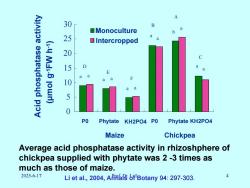
30 B ☐Monoculture 25 圆Intercropped (-4 M1-6 lowrl) 20 15 D 10 a 0 Phytate KH2P04 PO Phytate KH2P04 Maize Chickpea Average acid phosphatase activity in rhizoshphere of chickpea supplied with phytate was 2-3 times as much as those of maize. 2025-6-17 Li et al.,2004,ARal of Botany 94:297-303. 4
2025-6-17 Prof. Dr. Li L 4 A cid p h o s p h a t a s e a c tivit y ( μ m ol g-1 F W h-1 ) 0 5 10 15 20 25 30 P0 Phytate KH2PO4 P0 Phytate KH2PO4 Maize Chickpea Monoculture Intercropped A B C D E F a a a a a a b a a a a a Li et al., 2004, Annals of Botany 94: 297-303. Average acid phosphatase activity in rhizoshphere of chickpea supplied with phytate was 2 -3 times as much as those of maize
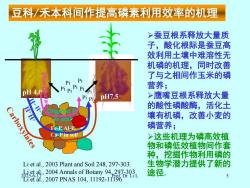
豆科/禾本科间作提高磷素利用效率的机理 >蚕豆根系释放大量质 子,酸化根际是蚕豆高 效利用土壤中难溶性无 机磷的机理,同时改善 了与之相间作玉米的磷 P Pi p 营养 pH7.5 >鹰嘴豆根系释放大量 的酸性磷酸酶,活化士 arboxylat 壤有机磷,改善小麦的 Fe-P Al- 磷营养; Ca-P in soil >这些机理为磷高效植 s 物和磷低效植物间作套 种,挖掘作物利用磷的 Li et al.,2003 Plant and Soil 248,297-303 生物学潜力提供了新的 器}307No2, 途径 5
2025-6-17 Prof. Dr. Li L 5 H pH7.5 + Pi Pi Pi Pi Pi Pi Ph o s ph at a s e pH 4.0 Li et al., 2003 Plant and Soil 248, 297-303. Li et al., 2004 Annals of Botany 94, 297-303 Li et al., 2007 PNAS 104, 11192-11196 Ø蚕豆根系释放大量质 子,酸化根际是蚕豆高 效利用土壤中难溶性无 机磷的机理,同时改善 了与之相间作玉米的磷 营养; Ø鹰嘴豆根系释放大量 的酸性磷酸酶,活化土 壤有机磷,改善小麦的 磷营养; Ø这些机理为磷高效植 物和磷低效植物间作套 种,挖掘作物利用磷的 生物学潜力提供了新的 途径. Pi Pi Pi H+ H+ H+ Fe-P, Al-P, Ca-P in soil Organic P in soil 豆科/禾本科间作提高磷素利用效率的机理 Carboxylates
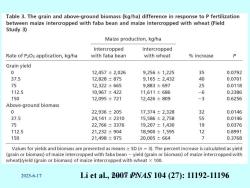
Table 3.The grain and above-ground biomass (kg/ha)difference in response to P fertilization between maize intercropped with faba bean and maize intercropped with wheat(Field Study 3) Maize production,kg/ha Intercropped Intercropped Rate of P2Os application,kg/ha with faba bean with wheat increase Grain yield 0 12,457±2,026 9,256±1,225 35 0.0792 37.5 12,828±875 9,165±2,432 40 0.0701 75 12,322±665 9,883±697 25 0.0118 112.5 10,967±422 11,611±686 6 0.2386 150 12,095±721 12,426±809 -3 0.6256 Above-ground biomass 0 22,936±205 17,374±2,328 32 0.0146 37.5 24,141±2310 15,586±2,758 55 0.0146 75 22,766±3376 19,207±1,430 19 0.0376 112.5 21,232±904 18,900±1,595 12 0.8991 150 21,498±975 20,005±664 0.3768 Values for yields and biomass are presented as means +SD(n=3).The percent increase is calculated as yield (grain or biomass)of maize intercropped with faba bean-yield(grain or biomass)of maize intercropped with wheat]/yield(grain or biomass)of maize intercropped with wheat x 100. 2025-6-17 Li et al.,200.PWAS104(27):11192-11196
2025-6-17 Li et al., 2Pr0of0. D7r. LPi NL AS 104 (27): 11192-111966
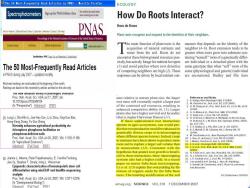
The 50 Iost-Frequently Read Articles in PNAS-Iozilla Firefox ECOLOGY Spectrophotometers Sign up for PNAS OnlineeTocs toiedbymalwhe 2stenteMgo60ne How Do Roots Interact? 曲8o时bo5 Cont9e PNAS Hans de Kroon Plant roots recognize and respond to the identities of their neighbors. ofthe Natncdemy of fthe UniteStaeAm Curent issue Archives OnliheSwtmsslon he main function of plant roots is the manner that depends on the identity of the acquisition of mineral nutrients and neighbor (46).Root extension tends to be water from the soil.Roots do not greater when roots grow into substrate con- Institution:PRC Signnas mber/Indiidual encounter these belowground resources pas- taining onself"roots of a genetically differ- sively,but actively forage for nutrient hot spots ent individual or a detached plant with the The 50 Most-Frequently Read Articles (/and avoid patches where root densities same genotype than when“self”roots of the of competing neighbors are high(2).These same (physiological and genetic)individual inPNAS dungJuly 2007updated mont responses can be driven by local nutrient con- are encountered.Dudley and File have Mlosteadrankingsaerecaltuitedathetegnimgcthemonth Rankings are basedtsreced byaricsite ine new mutuon meory o pnenotypic evoruuon Proc.Natl.Acad.Sci.USA Jul 17,2007:doi: ume relative to mature plant size,the larger 10.1073pnas.0703349104 root mass will eventually exploit a larger part 1 (In "Perspective)[Abstract][PDF] of the contested soil resources,resulting in 2 enhanced competitive ability (6,1/).Larger plants also have higher survival and fecundity G.G.Maina et ol,Plant Ecol.160,235 (2002). 9.LongLi,Shu-Min Li,Jian-Hao Sun,Li-Li Zhou,Xing-u Bao, (that is,higher Darwinian fitness)(). 56 Hong-Gang Zhang.Fu-Suo Zhang If these sophisticated root interactions 2123 Diversiytivity vi operate in agro-ecosystems.one would pre- rhizosphere phosphorus facilitation on dict that root production would be enhanced in 7.S.A.Dudley.A.L Flle,BfoL Lert.3,435 (2007). 8.B.E.Mahall.R.M.Callaway.Am.).Botony 83.93 phosphorus-deficient soils genetically diverse crops or in intercropping Proc.Natl.Acad.Sci.USA Jul 03,2007:104:11192-11196. where different species interact.Indeed,crops New Phytolog176,644(2007 n1Ea952412007 In "Agricultural Sciences") in mixtures have been shown to produce more 11 )Weiner,Trends EcoL Evol.5.360 (1990). Abstract][Full Text][PDF] roots and to explore a larger soil volume than in monoculture (12).Consistent with the L.U et al,Proc.Natl.Acod.So.US.A 104,11192 hypothesis that greater root growth is benefi- 3.e LAltema,Peter Papathanasiou,E.Camilla Forsberg, cial in these interactions,these intercropping systems also had a higher yield.In a recent Jian Xu,Stephen T.Smale,Irving L.Weissman paper on maize -faba bean intercropping. Epigenetic characterization of hematopoietic stem cell nd ng5 Li et al.(13)explain this overyielding by the differentiation using miniChlP and bisulfite sequencing release of organic acids by the faba bean analysis roots.The resulting acidification of the soil 10.1126ceme.1150726 P10c.Natl.Acad.Sci.USA Jul24,2007:104:12371-12376 (In"Developmental Biology) Abstract]IFull Text][PDF] emag.org SCIENCE VOL 318 7 DECEMBER 2007
2025-6-17 Prof. Dr. Li L 7
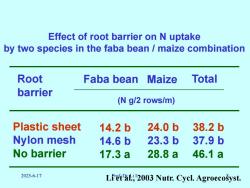
Effect of root barrier on N uptake by two species in the faba bean maize combination Root Faba bean Maize Total barrier (N g/2 rows/m) Plastic sheet 14.2b 24.0b 38.2b Nylon mesh 14.6b 23.3b 37.9b No barrier 17.3a 28.8a 46.1a 2025-6-17 LPet,2003 Nutr.Cycl.Agroecosyst
2025-6-17 Prof. Dr. Li L 8 (N g/2 rows/m) 14.2 b 14.6 b 17.3 a 24.0 b 23.3 b 28.8 a 38.2 b 37.9 b 46.1 a Effect of root barrier on N uptake by two species in the faba bean / maize combination Root Maize Total barrier Faba bean Plastic sheet Nylon mesh No barrier Li et al., 2003 Nutr. Cycl. Agroecosyst
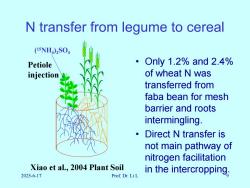
N transfer from legume to cereal (5NH4)2S04 Petiole Only 1.2%and 2.4% injection of wheat N was transferred from faba bean for mesh barrier and roots intermingling. ·Direct N transfer is not main pathway of nitrogen facilitation Xiao et al.,2004 Plant Soil in the intercropping, 2025-6-17 Prof.Dr.Li L
2025-6-17 Prof. Dr. Li L 9 N transfer from legume to cereal • Only 1.2% and 2.4% of wheat N was transferred from faba bean for mesh barrier and roots intermingling. • Direct N transfer is not main pathway of nitrogen facilitation in the intercropping. ( 15NH4)2SO4 Petiole injection Xiao et al., 2004 Plant Soil
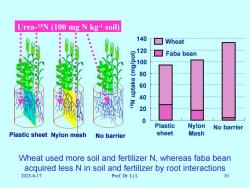
Urea-15N (100 mg N kg-1 soil) 140 Wheat 120 Faba bean 1 80 20 0 Plastic Nylon No barrier Plastic sheet Nylon mesh No barrier sheet Mesh Wheat used more soil and fertilizer N,whereas faba bean acquired less N in soil and fertilizer by root interactions 2025-6-17 Prof.Dr.LiL 10
2025-6-17 Prof. Dr. Li L 10 Wheat used more soil and fertilizer N, whereas faba bean acquired less N in soil and fertilizer by root interactions Urea- 15N (100 mg N kg -1 soil) Plastic sheet Nylon mesh No barrier 0 20 40 60 80 100 120 140 Plastic sheet Nylon Mesh No barrier 15 N u p t a k e (m g / p o t)Faba bean Wheat
按次数下载不扣除下载券;
注册用户24小时内重复下载只扣除一次;
顺序:VIP每日次数-->可用次数-->下载券;
- 《生物多样性导论》课程教学课件(PPT讲稿)17 遗传多样性.ppt
- 《生物多样性导论》课程教学课件(PPT讲稿)14 农田生态系统中生物多样性应用.ppt
- 《生物多样性导论》课程教学课件(PPT讲稿)12 植物获取营养的多样性.ppt
- 《生物多样性导论》课程教学课件(PPT讲稿)13 农田生态系统中生物多样性应用.ppt
- 《生物多样性导论》课程教学课件(PPT讲稿)11 珍稀动物.ppt
- 《生物多样性导论》课程教学课件(PPT讲稿)09 物种多样性 species diversity.ppt
- 《生物多样性导论》课程教学课件(PPT讲稿)10 中国稀有濒危植物.ppt
- 《生物多样性导论》课程教学课件(PPT讲稿)07 水域生态系统 Water Ecosystem.ppt
- 《生物多样性导论》课程教学课件(PPT讲稿)08 荒漠生态系统.ppt
- 《生物多样性导论》课程教学课件(PPT讲稿)04 热带雨林生态系统.ppt
- 《生物多样性导论》课程教学课件(PPT讲稿)06 湿地生态系统 Wetland Ecosystem.ppt
- 《生物多样性导论》课程教学课件(PPT讲稿)05 热带雨林生态系统.ppt
- 《生物多样性导论》课程教学课件(PPT讲稿)01 绪论(中国农业大学:李隆).ppt
- 《生物多样性导论》课程教学课件(PPT讲稿)03 生态系统多样性 Ecosystem diversity.ppt
- 《生物信息学》课程教学大纲 Fundamental concept of bioinformatics.doc
- 《普通植物形态解剖学》课程教学课件(讲稿)第一章 植物细胞(1/3).pdf
- 《普通植物形态解剖学》课程教学课件(讲稿)第一章 植物细胞(2/3).pdf
- 《普通植物形态解剖学》课程教学课件(讲稿)绪论 General Plant Morphology and Anatomy.pdf
- 《普通植物形态解剖学》课程教学课件(讲稿)第三章 根系的形态结构与建成过程.pdf
- 《普通植物形态解剖学》课程教学课件(讲稿)第二章 植物组织.pdf
- 《生物多样性导论》课程教学课件(PPT讲稿)18 遗传多样性(1/3).ppt
- 《生物多样性导论》课程教学课件(PPT讲稿)20 遗传多样性(3/3).ppt
- 《生物多样性导论》课程教学课件(PPT讲稿)19 遗传多样性(2/3).ppt
- 《植物生物学野外实习》课程教学课件(PPT讲稿)植物标本的采集、制作和保存和鉴定.ppt
- 《植物生物学野外实习》课程教学课件(PPT讲稿)科技论文的写作.ppt
- 《微生物生理学》课程教学大纲 Microbial Physiology.doc
- 《微生物生理学》课程授课教案(主讲教师:关国华、陈文峰).doc
- 《微生物生理学》课程实验指导技术(共六个实验).pdf
- 《微生物生理学》课程教学课件(讲稿)第四章 微生物的合成代谢(4/7).pdf
- 《微生物生理学》课程教学课件(讲稿)第四章 微生物的合成代谢(5/7).pdf
- 《微生物生理学》课程教学课件(讲稿)第四章 微生物的合成代谢(7/7).pdf
- 《微生物生理学》课程教学课件(讲稿)第四章 微生物的合成代谢(6/7).pdf
- 《微生物生理学》课程教学课件(讲稿)第四章 微生物的合成代谢(3/7).pdf
- 《微生物生理学》课程教学课件(讲稿)第四章 微生物的合成代谢(1/7).pdf
- 《微生物生理学》课程教学课件(讲稿)第四章 微生物的合成代谢(2/7).pdf
- 《微生物生理学》课程教学课件(讲稿)第三章 产能代谢 Energy Yielding Metabolism(4/7).pdf
- 《微生物生理学》课程教学课件(讲稿)第三章 产能代谢 Energy Yielding Metabolism(5/7).pdf
- 《微生物生理学》课程教学课件(讲稿)第三章 产能代谢 Energy Yielding Metabolism(7/7).pdf
- 《微生物生理学》课程教学课件(讲稿)第三章 产能代谢 Energy Yielding Metabolism(6/7).pdf
- 《微生物生理学》课程教学课件(讲稿)第二章 代谢概论 An Introduction to Microbial Metabolism.pdf
